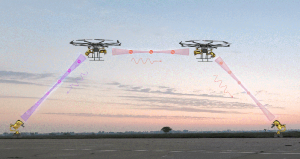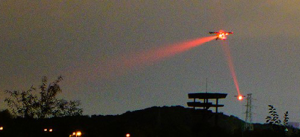
Scientists have set up a drone-based quantum network, transferring a quantum signal over a kilometer of open air, according to APS Physics.
Although it’s a limited space, the demonstration shows the ability for quantum signals to be transmitted wirelessly, which has enormous defense and security implications.
The Chinese-led research team reported their findings in Physical Review Letters.
Establishing a quantum network using drones could allow the transmission of fully secure messages. For example, two users could rely on entangled photons to communicate without the possibility of eavesdropping. While these quantum signals have been transmitted through optical fibers (Viewpoint: Record Distance for Quantum Cryptography) and through satellite links (Focus: Intercontinental, Quantum-Encrypted Messaging and Video), passing these extremely sensitive signals through open space offers significant challenges.

APS Physics points out that the airwaves are already crammed with a range of communications traffic — cell phone, radio and Wi-Fi signals. Also, diffraction represents a problem. As a photon propagates, its wave spreads out and, at a certain point, it will have little chance of being collected.
The researchers set up the network with a drone, which generated pairs of infrared photons whose polarization orientations were entangled. Then, the drone used a high-speed tracking system to direct one photon to a ground station, referred to as Alice, and another station called Bob. Each station was equipped with a telescope having a 26-mm-wide aperture and a single-photon detector to collect the incoming photons.

In this study, the team hoped to address the limitations caused by diffraction by adding a second drone that acts as a relay between the first drone and Bob. This drone collects photons from the first drone and focus through an optical fiber to improve higher chance of relaying the signal.
A Bell inequality test was used to compared the photon polarizations received at Alice and Bob. Those results confirmed that the photons remained entangled, which means the quantum information survived the trip, according to APS Physics.
A drone-based quantum network offers several advantages, according to the researchers.
“Drones can be deployed for a mobile quantum connection at any given time and location when necessary,” says Zhenda Xie, of Nanjing University, and one of the members of the research team. Drones can also easily be repositioned to avoid pollution or fog. They may also be less expensive and more agile compared to satellite quantum systems.
Martin Bohmann, a quantum information specialist at the Austrian Academy of Sciences in Vienna, told the physics outlet that it could allow free-space communication between partners that do not have a direct line of sight.
Photon transmission losses would need to be reduced to make a multidrone system competitive with other quantum network technologies, according to Bohmann.
The team will now try to enlarge the network size with multiple drones. This could create quantum links across a city, for example.
The research team included: Hua-Ying Liu, Xiao-Hui Tian, Changsheng Gu, Pengfei Fan, Xin Ni, Ran Yang, Ji-Ning Zhang, Mingzhe Hu, Jian Guo, Xun Cao, Xiaopeng Hu, Gang Zhao, Yan-Qing Lu, Yan-Xiao Gong, Zhenda Xie, and Shi-Ning Zhu
For more market insights, check out our latest quantum computing news here.


















